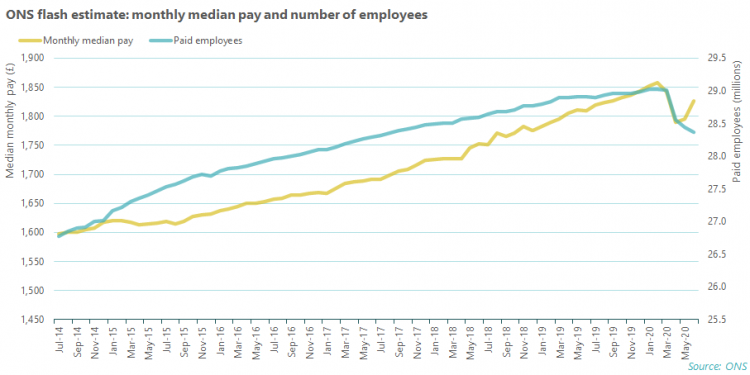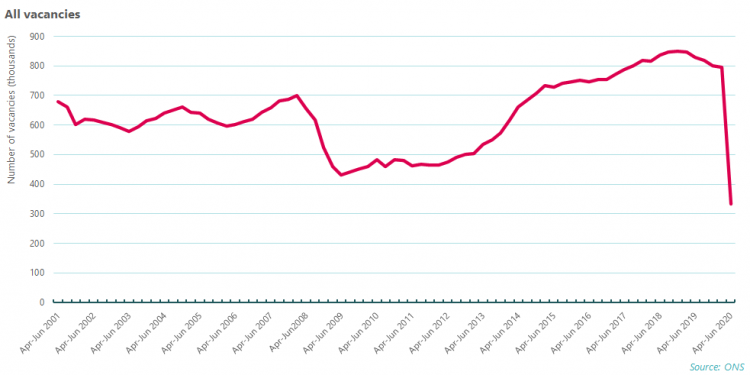We need bold action to avoid mass unemployment
The flash estimates based on Pay As You Earn (PAYE) data show that the number of paid employees fell by around 75,000 (0.3 per cent) in June, compared to the previous month. It’s down by 1.9 per cent compared to the same month last year. Median monthly pay went up slightly compared to the previous month, but has fallen by 1 per cent compared to June 2019 and remains lower than it was before the pandemic.
Since the start of the pandemic, the number of employees has fallen by 650,000 people and median monthly pay, despite the recent uptick, has dropped by £15 per month.

The Labour Force Survey (LFS) data, where we get the official measures of unemployment and pay, lags slightly behind this PAYE data so it has been slower to reveal the impact of the pandemic. But the latest data, covering the three-month period up to the end of May, is starting to show signs of a downturn in employment. Vacancies have fallen by 58 per cent since last quarter. This is the largest fall since records began in 2001, and vacancies are at their lowest ever level.
There’s also been a significant fall in hours worked, which have dropped 17 per cent compared to the previous quarter. This is the largest quarter-on-quarter fall on record.

Without action, the unemployment rate could triple
The latest data comes in the same week that the Office for Budgetary Responsibility (OBR) published three scenarios for what the economy will look like in the medium term. The report sets out a ‘central’ scenario, as well as a ‘downside’ and an ‘upside’ scenario.
The central scenario sees the unemployment rate tripling to 12 per cent. This would mean 4.1 million people unemployed. The more optimistic scenario has the rate rising to 10 per cent, which is higher than during the financial crisis. The more pessimistic scenario forecasts a rise to 14 per cent, the highest rate since the interwar period.
As the OBR says in its report, an important factor in determining which scenario we face is how the government handles the transition away from the Job Retention Scheme (JRS). The scheme has kept millions of people in work but is due to be phased out over the coming months, terminating in October.
The chancellor’s summer statement offered the first insight into how well the government will handle this transition. The Kickstart programme, a job guarantee scheme for young workers, is a step in the right direction. However, it needs improvements to make it fit to address the risk of mass unemployment.
Time for real action
Other measures announced include the job retention bonus, which gives employers £1,000 for every furloughed employee that they retain for three months after the furlough scheme ends in October. This is better than a cliff-edge ending, but does little to help the worst hit businesses.
A discount on meals out on Mondays to Wednesday is little more than a gimmick that’s unlikely to have much of an impact for an industry hit hard by the pandemic. Despite the impact on this sector, and the wave of retailers that have recently announced redundancies, there was no proposal to help the retail sector.
Businesses in the hardest hit sectors need specific and substantial support packages, designed with unions and businesses. These should include the option to take equity stakes in firms which need support, with the potential to drive more sustainable business models.
Where business models face major changes after the pandemic, government investment in public services and infrastructure can provide new jobs. Research for the TUC shows that an £85bn investment in green infrastructure could help create 1.24 million jobs in the next two years. Hundreds of thousands of vacancies in social care and the NHS could also be filled.
A new safety net
A meals-out voucher might be good for those who can afford it, but there was no good news for those who can’t afford essentials at a time when food banks are reporting unprecedented demand. As the food bank charity Trussell Trust pointed out:
People who are currently unable to afford food and other essentials – and those who are going to fall into this situation as the economic crisis continues to unfold – need an urgent boost to social security so they have enough to stay afloat.
It’s clear that our benefits system needs an overhaul if it’s to genuinely support those already out of work and those who lose their jobs over the coming months. This includes raising basic payments (as well as legacy benefits) to £260 per week and scrapping the five-week wait. This should be the start of replacing Universal Credit with a more generous and less punitive benefits system.
For those returning to work, it’s important that they’re brought back into work on the same terms and conditions as when they left, rather than on reduced pay or on worse terms.
Giving the threat we face, it’s time that the government starts making big leaps instead of taking small steps. We need investment in decent jobs and an overhaul of our cruel benefits system. Today’s data shows that we need them as soon as possible.
Stay Updated
Want to hear about our latest news and blogs?
Sign up now to get it straight to your inbox
